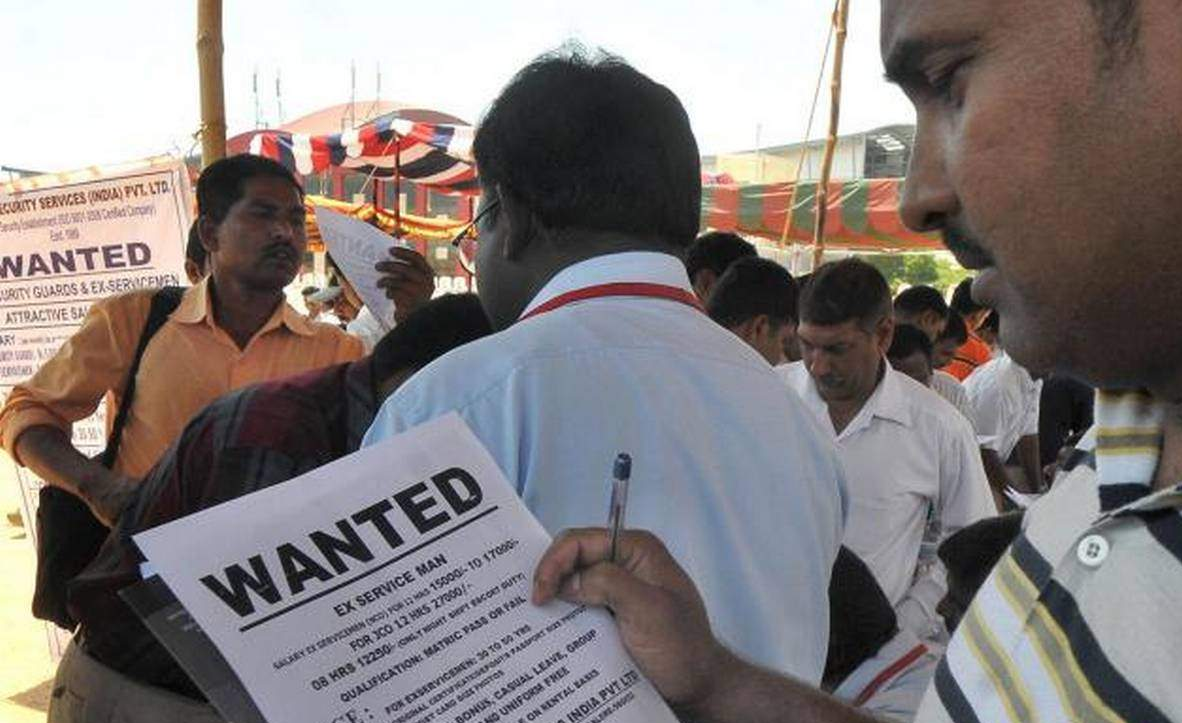By paulkoshy
India has a serious youth unemployment crisis on its hands.
In 2019, before Covid-19 brought global economic activity to a near standstill, data released by India’s Ministry of Statistics showed unemployment in the country was at a 45-year high. Unemployment among the well-educated was also at record levels: nearly three times the national average, according to a 2018 study by the Azim Premji University.
| Unemployment Rate in India as on 12th March * 30 days moving average Source: CMIE | |
| INDIA | 6.6% |
| URBAN | 7.2% |
| RURAL | 6.3% |
This has now been exacerbated by the fallout from the pandemic. The absence of uniform government data makes it hard to source exact unemployment rates, but an October-November 2020 survey of nearly 10,000 millennials conducted by Mint newspaper found 17 percent had lost their jobs since the pandemic began.
This has now been exacerbated by the fallout from the pandemic. The absence of uniform government data makes it hard to source exact unemployment rates, but an October-November 2020 survey of nearly 10,000 millennials conducted by Mint newspaper found 17 percent had lost their jobs since the pandemic began.
Many young adults around the world have faced huge job losses in the last year, but India’s lack of a safety net makes its youth particularly vulnerable to poverty and economic insecurity. Other countries are ageing while India gets younger. This means that lower wages and a decline in economic productivity due to the pandemic will compound the magnitude of the problem in India. Human capital accumulation, job growth, and skill development were all suspended during the pandemic.
The last thing you want is a generation which has squandered the best years of its life. It will create huge social problems as well.

As millions lost their jobs, many had to turn to MGNREGA, a government programme that guarantees 100 days of unskilled manual labour in rural areas and pays roughly Rs. 250 a day. Almost 17 million new workers applied to access the programme between April and September 2020, and 60 million households participated in the programme during that period – the highest number in its 14-year history.
| Unemployment Rate (%) Monthly time series. Source CMIE | |
| States | Feb 2021 |
| Andhra Pradesh | 3.9 |
| Assam | 1.6 |
| Bihar | 11.5 |
| Chattisgarh | 6.2 |
| Delhi | 8 |
| Goa | 21.1 |
| Gujarat | 3.2 |
| Harayana | 26.4 |
| Himachal | 15.1 |
| Jammu & Kashmir | 14.2 |
| Jharkhand | 12.1 |
| Karnataka | 2.5 |
| Kerala | 4.3 |
| Madhya Pradesh | 2.1 |
| Maharashtra | 3.8 |
| Meghalaya | 3.8 |
| Odisha | 2.5 |
| Puducherry | 5.8 |
| Punjab | 7.2 |
| Rajasthan | 25.6 |
| Sikkim | 4.3 |
| Tamil Nadu | 4.8 |
| Telangana | 5.7 |
| Tripura | 11.1 |
| Uttarakhand | 4.1 |
| Uttar Pradesh | 4.7 |
| West Bengal | 6.2 |
A significant change in inequality in income and wealth is possible only in a longer term perspective. Employment structure of an economy is the normal instrument that can cause a change in inequality either way, i.e. an increase or a decrease in the inequality. Other economic instruments such as target group policies and programmes have a short term impact, but the redistribution through employment is sustainable. Since the governments function within the administrative and fiscal constraints, the target group programmes normally have a marginal impact on income redistribution. Income of labour enables flow of resources across income classes of people and across the social and ethnic groups. Flows of income across locations are influenced both by assets available and by other modes of creating employment opportunities. However, income generated by employment of migrant labour, facilitates flow of resources across regions for a given regional distribution of capital assets. Employment and equity of income across classes of people and across regions are, therefore, closely related to each other in the long term.

Input of labour in production process depends upon technology used, and technology used varies across the industries. Traditional agriculture is more labour intensive than the modern manufacturing industries. With the modernization of economy, share of agriculture in workforce reduces due to two factors; food demand grows at a much slower pace at high levels of income, which moderates the demand for food-grains. Secondly, the technology used in agriculture, at higher yield levels is much less labour absorbing than traditional agriculture. Agriculture absorbed 65 to 70 per cent of workforce between the years 1991 and 2001 as per demographic Census. At all India level the proportion of workers getting work in agriculture came down by 9 percentage points between 1991 and 2001. In some of the States the number of agricultural workers in 2001 is less than in 1991. These substantial shifts in ability of agriculture to absorb labour are also confirmed by the NSSO survey on Employment – 55th Round (1999-2000)
| Unemployment Rate | |||
| Month | India | Urban | Rural |
| February 2021 | 6.90 | 6.99 | 6.86 |
| January 2021 | 6.53 | 8.08 | 5.83 |
| December 2020 | 9.06 | 8.84 | 9.15 |
| November 2020 | 6.50 | 7.07 | 6.24 |
| October 2020 | 7.02 | 7.18 | 6.95 |
| September 2020 | 6.68 | 8.45 | 5.88 |
| August 2020 | 8.35 | 9.83 | 7.65 |
| July 2020 | 7.40 | 9.37 | 6.51 |
| June 2020 | 10.18 | 11.68 | 9.49 |
| May 2020 | 21.73 | 23.14 | 21.11 |
| April 2020 | 23.52 | 24.95 | 22.89 |
| March 2020 | 8.75 | 9.41 | 8.44 |
| Statistical Profiles – Unemployment in India |
Though, as noted above, the share of agriculture in the total employment has been declining over the years, the pave of this decline has been slower than the decline in the share of agriculture in the GDP. As a result, a clear divergence has emerged between the shares of primary, secondary and tertiary sectors in employment and output, suggesting thereby large intersectoral differences in the per worker productivity.
The secular decline in the importance of agriculture sector in the overall economic structure is a part of economic development. Work Opportunities that are lost in traditional agriculture have to be replaced by work opportunities in some other sector. In the normal course it is the secondary sectors (manufacturing, electricity and construction) that grow much faster than agriculture during transition of an economy. However, in the post reform period the growth of manufacturing industries has been constrained by competition from imports.
Thus, in the medium term, the ability of manufacturing sector to replace the work opportunities lost in traditional agriculture is rather limited over the next 5 to 10 years.
There are immense possibilities for diversification in agricultural sector towards more value added activities such as food processing. This is an area, which has by and large remained unexploited, because reforms in agriculture sector having been very slow, resources have not yet started flowing into food processing industries. Involvement of State Governments in implementing reforms in agriculture and food processing sectors is of crucial importance. Economic returns from States initiatives in transforming the rural economy from traditional agriculture to more value added activities in horticulture, etc. has been demonstrated well in some of the States, such as Maharashtra and Himachal Pradesh. Such diversification has immense potential for bridging some of the gaps in productivity levels of workers in agriculture vis a vis other sectors.
Besides diversification of agriculture there is a strong need to restructure the rural economy by way of promotion of non farm activities in rural areas. Whatever non farm activities are being carried out in the rural areas now are more out of a desperation to eke out a living rather than an informed choice of a vocation, backed by infrastructural and institutional facilities. A massive improvement in infrastructure is required to promote growth of rural industries on a sustainable basis. This will go a long way in generating good quality employment and meeting many of the consumption requirements of rural people. Many steps have to be taken in regard to village for effective connectivity, e.g. development of physical connectivity through rural road and telecommunication. Power sector reforms are urgently needed to set up modern processing facilities. Another area requiring attention is tackling the bottlenecks in the availability of business services institutions – training, banking, insurance, storage facilities etc.
There is a need for National Employment Policy (NEP) that would encompass a set of multidimensional interventions covering a whole range of social and economic issues affecting many policy spheres and not just the areas of labour and employment.

The policy would be a critical tool to contribute significantly to achieve the goals of the 2030 Agenda for Sustainable Development.
The underlying principles for the National Employment Policy may include:
-Enhancing human capital through skill development;
-Creating sufficient number of decent quality jobs for all citizens in the formal and informal sectors to absorb those who are available and willing to work;
-Strengthening social cohesion and equity in the labour market;
coherence and convergence in various initiatives taken by the government;
-Supporting the private sector to become the major investor in productive enterprises;
-Supporting self-employed persons by strengthening their capabilities to improve their earnings;
-Ensuring employees’ basic rights and developing an education training and skill development system aligned with the changing requirements of the labour market.
There are number of labour intensive manufacturing sectors in India such as food processing, leather and footwear, wood manufacturers and furniture, textiles and apparel and garments. Special packages, individually designed for each industry are needed to create jobs.
Public investment in sectors like health, education, police and judiciary can create many government jobs.
Decentralisation of Industrial activities is necessary so that people of every region get employment.
Development of the rural areas will help mitigate the migration of the rural people to the urban areas thus decreasing the pressure on the urban area jobs.
Entrepreneurs generate employments to many in a country; therefore, government needs to encourage entrepreneurship among the youth.
Concrete measures aimed at removing the social barriers for women’s entry and their continuous participation in the job market is needed.
Government needs to keep a strict watch on the education system and should try to implement new ways to generate skilled labour force.
Based on findings from CMIE’s latest data, the unemployment rate in India rose to 7.2 percent in February 2019, the highest since September 2016, and up from 5.9 percent in February 2018.
The total number of employed persons in February 2019 is estimated at 400 million against 406 million in the year-ago period and 407.5 million employed in February 2017.
The labour participation rate fell from 43.2% in January 2019 to 42.7% in February 2019. Labour Participation Rate defines that section of working population in the economy which is currently employed or seeking employment.

A matter of great concern is that employment elasticity of organised sector has been very low at 0.066 during 1993-94 to 1999-2000, whereas it has been 0.213 for the unorganised sector. Employment elasticity of private corporate sector at 0.133 is much less than that of the unorganised sector. On the basis of these trends, there could be hardly any replacement by the organised sector of the work opportunities that shrink in agriculture. Hence, there will be a fast growth of informal sector by influx from rural areas.
These trends suggest two kinds of policy initiatives in regard to organised sector.
Firstly, we should promote use of labour intensive and capital saving technologies.
And secondly, the way the “organised sector” as defined at present needs a review.
One definition of organised sector is based on its capital intensity, i.e., the technology used. Other definition of organised sector is in terms of employment – the terms of contract between the employer and employee.
At present the terms of employment are seen to be rigid by the organised sector, with the result that though organised sector needs and uses a lot of labour input, it does not show up in jobs created. Similar tendencies have forced the capital intensity to increase even in the small-scale sector. If employment is the social purpose of a small-scale policy or small and medium enterprise policy then the policy should be designed in terms of jobs created rather than investments made.
The growth of formal sector (i.e., organised sector) has to be based on private sector in future. In some of the States, share of private sector jobs in organised sector has increased.
In so far as employment is concerned, the term organised sector has at present a narrow coverage. It so happens because the labour regulations and credit policy are not designed to be sensitive to the requirements of smaller establishments. If this were possible, an increase in the share of organized sector would be a desirable objective to be pursued in a longer term perspective as steps to improve quality of employment are more feasible to be taken in a structured environment of exchange of labour services, than under purely informal conditions. (conditions in this sector are better and it also offers workers in its fold the advantages of a fairly comprehensive social security.) However, there are two factors which would severely affect the prospects of organised sector of employment, as it is presently defined, (this sector) emerging as a major employer even in a 20 years’ perspective.
Firstly, the base of the sector is very small and therefore the overall impact of even a very fast growth of employment in this sectors will be only marginal.
Secondly, within the organized sector, the employment growth potential in the Public sector, which accounts for approximately 70% of the total organized employment, is very limited.
The above two factors coupled with the declining employment elasticity in the sector preclude emergence of this sector as a major job provider in the near future. In this scenario, the predominance of informal sector, including agriculture, is likely to continue and therefore the concerns of the smaller establishments (informal sector) which are crucial to its growth and also of the workers, which is today a vulnerable lot, need to be attended to. Marginal improvement in the tools used by the artisans, access to institutional credit, some amount of skill orientation and the general information about the availability of markets for different products will improve the performance of the sector as well as help the individual workers immensely.
The reach of the social security benefits is largely restricted to the workers in the formal or the organized sector barring a few attempts to reach the informal sector workers through welfare boards. A large proportion of the workers is still left out of any system of social security. There is a need to earnestly address to the welfare needs of the workers in the informal sector. This does not necessarily require bringing the sector under the purview of labour laws. Introduction of labour laws might kill the greatest advantage that this sector has in terms of flexibility in operation, through rigidities which are generally inherent in application of such laws. This also cannot be done on the basis of an employer-employee relationship, as in the organized sector, because majority of the workers in informal sector are self-employed. Only through a participatory approach between the governments and the workers can emerge a sustainable system of social security for informal sector workers.
The levels of vocational skills in the labour force in India compare poorly with the position in other countries. The percentage of younger members of the labour force (age group 20-24), which have vocational training. Only 5% of the Indian labour force in this age category has vocational skills whereas the percentage in industrial countries is much higher, varying between 60% and 80%, except for Italy, which is 44%. The percentage for Korea, which has recently been categorised as an industrialised country, is exceptionally high at 96%.
The developing countries listed have percentages which are significantly lower than the developed countries, but they are still much higher than India e.g. Mexico at 28% and Peru at 17%. Differences in definition may make inter-country comparison somewhat unreliable, but the level in India is clearly far too low. These figures reveal that education and skill levels of our labour force are relatively low compared with other fast growing developing countries. The system is also excessively oriented towards general academic education with little or no vocational orientation.

The preference for general education is driven primarily by the perception that an academic degree is necessary to obtain a government job, which is highly valued because job security is virtually complete and pay scales are typically much above market wages. The net result is that the education system has neglected the need to provide vocational skills and to generate awareness and demand among students for acquiring, marketable skills.
In the long term, a strategy to impart vocational skills will facilitate increase in income of labour. A massive expansion of training facilities is needed. As we shall see in later section, the occupational profile of workers will change at a rapid pace because the traditional avenues for work in agriculture are poised to alter substantially, as ability of this sector to absorb labour force will diminish at a fast pace. Greater emphasis on vocational training in relation to general education is required.
This requires improvement in quality of education, job training, up gradation of skills, and interface between industry, policy makers and training institutions. However, this also requires creation of adequate decent jobs in the non-farm sector the mainly manufacturing as is envisaged in the 12 Plan. In the Indian context, to make the youth employable, the government of India is laying emphasis on skill development and has set a target of skilling 500 million by 2022 and 50 million in the 12th plan. To achieve this target, National Policy on Skill Development focuses on improving quality, quantity, access and outreach of training. Different innovative measures have been followed to reach the difficult areas. Some of the good examples are in terms of virtual classrooms, mobile vans, simulation based etc. There are 23 Central Ministries, which are engaged in skill development. In order to recognize the prior learning, workers are tested and given certificates of trained manpower. There are general programmes, group-specific and region.

The National Skill Development Agency has been mandated to monitor the progress of skilling in the country, operationalise the National Skill Qualification Framework, which facilitates both horizontal and vertical mobility and makes skill aspirational among the prospective trainees.
In addition, there is an urgent need to speed up the setting up of the Sector Skills Councils and putting in place the National Occupational Standards to make National Skill Qualification System operational. This would facilitate modification of curriculum in tune with the industry’s requirement.
At present, there is no organised and scientific system in place to provide labour market information in terms of supply-demand position in the labour market to guide the labour and training policies, training providers, prospective labour force and the employers. There is an urgent need to put in place the same. To make manufacturing an engine of growth and to generate employment opportunities, the government has announced new policies as part of the 12th Five year Plan, aiming to create 100 million work opportunities by 2022, mainly in labour intensive manufacturing sectors such as textiles, gems & jewellery, and leather industry.
For those who are engaged in self-employment, hand holding in terms of credit availability as also market and technical assistance is provided in the industrial policy th and the 12 Plan focusses on strengthening this further.
It is not appropriate to project GDP growth and employment elasticities over a long period of 25 years. The scenario of employment in 2020 will develop based on certain underlying trends in regard to factors which prevail in the longer term. Though the growth of labour force will slow down, but the elasticity of employment will also fall, which means that pressure on labour market will not ease. As agricultural work opportunities continue to shrink, the informal sector will grow rapidly.
To cope up with such expected trends, strategies are needed to promote labour intensive and capital saving technologies. Employment creation in small establishments will have to be promoted by incentives linked with jobs created rather than capital invested. Migrant labour will increase social pressures. A strategy to raise the wage levels of those who migrate will have to be based on a massive programme for development of vocational skills.
A simple but broad based social security system will have to be developed to improve quality of employment in a scenario where migrant workers will be rapidly growing. Such a social security system coupled with better labour incomes, based on better productivity of trained manpower, will facilitate the conversion of emerging work opportunities into meaningful jobs, where chances of extreme exploitation of labour get eliminated.
To conclude, there should be an integrated policy focus in the coming years on promoting growth that supports livelihood.
Paul Koshy writes on a wide variety of subjects. He is a thought leader, an advisor to various governments on infrastructure development. His passionate practice in framing policies for inclusive and equitable growth for all including our ecosystem makes his contributions unique and valuable


